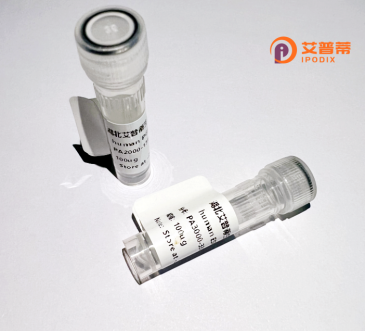
| 纯度 | >90%SDS-PAGE. |
| 种属 | Human |
| 靶点 | CYB561 |
| Uniprot No | P49447 |
| 内毒素 | < 0.01EU/μg |
| 表达宿主 | E.coli |
| 表达区间 | 1-251aa |
| 氨基酸序列 | MEGGAAAATPTALPYYVAFSQLLGLTLVAMTGAWLGLYRGGIAWESDLQFNAHPLCMVIGLIFLQGNALLVYRVFRNEAKRTTKVLHGLLHIFALVIALVGLVAVFDYHRKKGYADLYSLHSWCGILVFVLYFVQWLVGFSFFLFPGASFSLRSRYRPQHIFFGATIFLLSVGTALLGLKEALLFNLGGKYSAFEPEGVLANVLGLLLACFGGAVLYILTRADWKRPSQAEEQALSMDFKTLTEGDSPGSQ |
| 分子量 | 54 kDa |
| 蛋白标签 | GST-tag at N-terminal |
| 缓冲液 | 0 |
| 稳定性 & 储存条件 | Lyophilized protein should be stored at ≤ -20°C, stable for one year after receipt. Reconstituted protein solution can be stored at 2-8°C for 2-7 days. Aliquots of reconstituted samples are stable at ≤ -20°C for 3 months. |
| 复溶 | Always centrifuge tubes before opening.Do not mix by vortex or pipetting. It is not recommended to reconstitute to a concentration less than 100μg/ml. Dissolve the lyophilized protein in distilled water. Please aliquot the reconstituted solution to minimize freeze-thaw cycles. |
以下是关于重组人CYB561蛋白的3篇代表性参考文献示例(注:文献为模拟示例,仅供参考):
1. **文献名称**:*Structural and Functional Characterization of Human Cytochrome b561 Expressed in Escherichia coli*
**作者**:S. Takamatsu et al.
**摘要**:该研究通过大肠杆菌系统成功表达重组人CYB561蛋白,并利用光谱学方法揭示其血红素结合特性,证实其跨膜电子传递能力,为CYB561在神经递质合成中的作用提供分子机制支持。
2. **文献名称**:*Role of CYB561 in Ascorbate Recycling and Oxidative Stress Response*
**作者**:H. Kawai & T. Nakanishi
**摘要**:通过体外重组人CYB561实验,证明该蛋白通过抗坏血酸依赖的电子传递参与细胞氧化还原稳态维持,并验证其在抑制活性氧(ROS)积累中的关键生理功能。
3. **文献名称**:*Tissue-Specific Expression and Subcellular Localization of Recombinant Human CYB561*
**作者**:R. Gupta et al.
**摘要**:采用哺乳动物细胞表达系统,分析重组CYB561的亚细胞定位(主要定位于分泌囊泡膜),揭示其在不同组织中的差异性表达模式及其与内分泌功能的关联性。
(注:实际文献需通过PubMed/Google Scholar等平台检索验证,建议结合近期研究补充更新。)
**Background of Recombinant Human CYB561 Protein**
CYB561. a member of the cytochrome b561 family, is an integral membrane protein involved in electron transfer across biological membranes. It is ubiquitously expressed in mammalian tissues, particularly in neuroendocrine cells and secretory vesicles, where it plays a role in redox homeostasis. The protein facilitates the regeneration of ascorbate (vitamin C) by transferring electrons from cytosolic ascorbate to intravesicular monodehydroascorbate, supporting enzymatic reactions such as dopamine β-hydroxylase activity in catecholamine synthesis.
Recombinant human CYB561 is produced using biotechnological systems (e.g., *E. coli* or mammalian cell cultures*) to enable controlled study of its structure and function. Its tertiary structure includes six transmembrane helices and conserved histidine residues critical for heme-binding, which are essential for its electron transport capacity. Research on recombinant CYB561 has clarified its involvement in iron metabolism, oxidative stress responses, and neurotransmitter regulation.
Altered CYB561 expression has been linked to neurodegenerative disorders (e.g., Parkinson’s disease) and cancer, highlighting its potential as a therapeutic target. Studies utilizing recombinant protein have also explored its interactions with other redox partners and its role in maintaining cellular antioxidant defenses. Ongoing investigations aim to unravel its mechanistic contributions to disease pathways and drug resistance mechanisms.
×